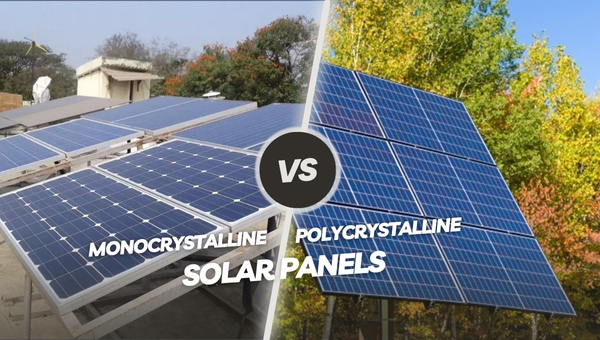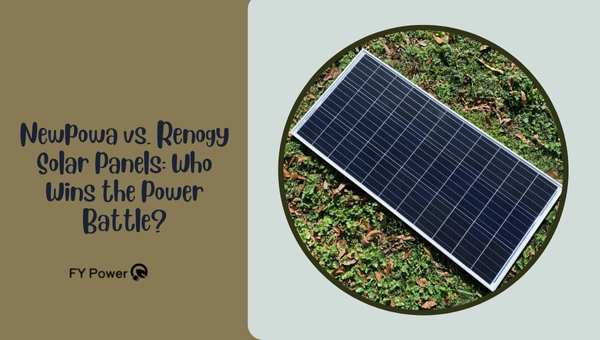When you think of solar power, what’s the first thing that pops into your mind? Shiny panels soaking up the sun, right? Well, behind those silent sun-catchers is a whirlwind of science making sure that clean energy gets packed away safely.
One little piece of that science decides how effectively this happens: charge controllers. Now, there’s a bit of a squabble in solar town – which charge controller reigns supreme when it comes to efficiency? I’m here to crack open this can of worms. Everyone’s buzzing about “PWM vs MPPT efficiency,” but why does it matter and how will it affect you?
Let me get down to the nitty-gritty and clear up the confusion once and for all. A PWM (Pulse Width Modulation) charge controller is like your sensible old uncle – reliably managing your solar energy but with traditional methods.
An MPPT (Maximum Power Point Tracking) charge controller, on the other hand, is like a smart tech whiz-kid who squeezes out every drop of power with cutting-edge technology. When it comes down to cold hard figures, MPPT usually takes home the trophy for being more efficient than PWM. However, there’s more to this story than just numbers; stick around as we delve deeper into what makes each one tick.
What You’ll Reap from This Read
- Unwrap the mystery behind PWM vs MPPT efficiency
- Harness wisdom on which controller fits your sunshine story
- Expert insights laid out in super simple language
- Practical tips on choosing solar smarts for your space
Quick Comparison of PWM vs MPPT Charge Controllers
Selecting the right charge controller is crucial for optimizing your solar power system’s efficiency and performance. This table provides a quick comparison of two popular options: Pulse Width Modulation (PWM) and Maximum Power Point Tracking (MPPT). Understanding their key differences empowers you to make an informed decision based on your specific needs and budget.
| Feature | PWM | MPPT |
|---|---|---|
| Technology | Older, simpler | Newer, more advanced |
| Cost | Lower | Higher |
| Efficiency | Lower (70-80%) | Higher (90-95%) |
| Performance in low light | Lower | Higher |
| Performance in hot weather | Lower | Higher |
| Battery compatibility | Lead-acid, gel | Lead-acid, gel, lithium |
| Cable length limitations | More sensitive to long cable runs | Less sensitive to long cable runs |
| Best for | Small systems, budget-conscious setups | Larger systems, cloudy or shaded locations, long cable runs |
PWM vs MPPT Efficiency: Breaking Down the Basics
When I’m setting up a solar power system, choosing the right charge controller is a big deal. It’s like picking the best coach for a sports team. Two main types are out there: PWM and MPPT. So let me break down what these are.
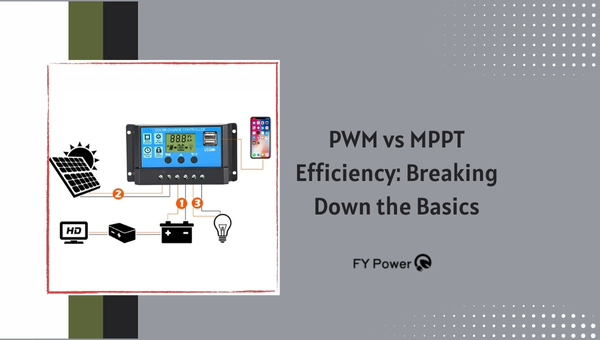
Defining PWM and MPPT
PWM stands for Pulse Width Modulation. Think of it as a basic but clever way to keep your batteries charged just right. It does this by switching the electrical path to the batteries on and off really quickly, sort of like blinking lights fast so they don’t shine too bright.
On the flip side, MPPT, short for Maximum PowerPoint Tracking, is like the smart kid in class who always gets an A+. It looks at what your solar panels can do and figures out how to get the most juice out of them to charge your batteries – even when the Sun’s being shy.
Here’s why they matter:
- PWM controllers are like older phones; simple and easy to use but not that powerful.
- MPPT controllers are more like smartphones; they’ve got more brains, do more stuff, definitely pricier, but give you more bang for your buck when it counts.
So in my solar setup journey:
I use a PWM charge controller when I’ve got smaller needs or my pockets aren’t deep. Cause they’re good enough and save me some cash. But if I’m going big or want top efficiency from my panels no matter what Mother Nature throws at me – yep, I pick an MPPT charge controller.
Comparing Conversion Efficiency
When someone says “conversion efficiency,” think about how much sunlight gets turned into usable power for my stuff or saving in batteries.
- With PWMs, imagine trying to fill up two different-sized cups (panel & battery voltages) by pouring water from one into another without spilling – tricky right? That’s PWM handling power; some energy gets lost because it’s not as smooth.
- MPPTs have this magic touch where they adjust their pouring style so almost every drop goes where it should. They take whatever my panels dish out and change it up perfectly so my batteries can lap it up – less waste!
And why do we care about this ‘efficiency’ thing? Well:
- The better this works (and trust me, with solar panel technology, sometimes we need all the help we can get), the less money I throw at electric bills or extra panels.
- This also means if Sunshine’s playing hide-and-seek or doing a mini winter no-show, my lights won’t flicker off because MPPT dug out every ounce of power possible.
The Significance of Charge Controllers in Solar Systems
When I think about making the most out of the sun’s power, I know charge controllers play a big part in solar systems. These little devices do so much work to keep our batteries safe and lasting longer.
They are like smart guards that make sure everything runs smoothly and efficiently, no matter if we’re talking about a small setup at home or a big one for a business.
The Function of Charge Controllers
Charge controllers serve one main goal: they manage the power that comes from solar panels before it goes into the batteries. Here’s why they’re so important:
- Protect batteries: Without these controllers, batteries could get too much juice and get damaged. It’s their job to make sure this doesn’t happen.
- Prevent overcharging: They watch the battery levels like hawks and slow down the charging when needed.
- Keep electricity steady: Solar energy can be up and down because of clouds or time of day. Controllers smooth this out so our gadgets don’t face those ups and downs.
- Avoid too much drain: At night or on cloudy days, they stop the batteries from giving away too much power.
These helpers make solar setups smarter—keeping things running without asking us to check them all the time.
How They Influence Your Solar Power System?
Both PWM (Pulse Width Modulation) charge controllers and MPPT (Maximum Power Point Tracking) charge controllers can have a big impact on your solar system’s health:
- System efficiency: Efficiency is key in getting as much power as possible from your panels. MPPTs are top-notch here—they squeeze out more energy than PWMS can under most conditions.
- Battery life: Batteries can wear out fast if not cared for right. PWMs do it simply but well enough for smaller setups, while MPPT technology shines by adjusting better to what your battery needs, giving them a longer life.
- Cost over time: An MPPT might cost more upfront, but it could save money in the long run thanks to its efficiency gains—especially if you’ve got a bigger system.
In-Depth Comparison: PWM vs MPPT Efficiency
When we talk about harnessing solar energy, charge controllers come into the picture as a key part of the system. They keep the batteries from overcharging by controlling the voltage and current coming from solar panels to batteries.
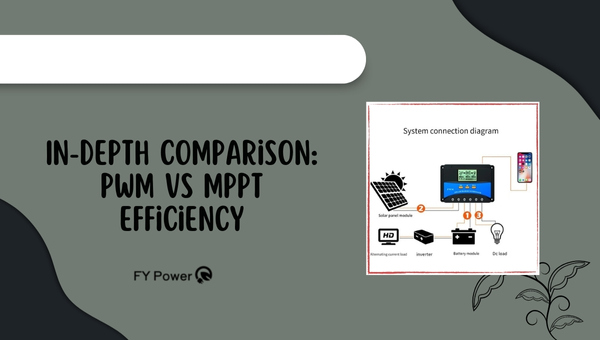
If you’re deciding between a PWM (Pulse Width Modulation) and an MPPT (Maximum Power Point Tracking) charge controller, it’s important to understand how they stand up against each other in terms of efficiency. Let’s dig deep into how these two types perform under different circumstances and what their durability looks like.
Performance Under Various Conditions
Controllers are like managers for your solar power—they have to adapt to whatever nature throws at them. Let’s see how they do that:
- PWM Charge Controllers:
- They work best when it’s sunny out.
- In shade or low light, they can’t grab much power because they match the panel voltage to the battery voltage.
- When it gets hot, their efficiency might go down since solar panel voltage drops and there’s less for PWM to work with.
- MPPT Charge Controllers:
- These guys are smarter at dealing with changes—they adjust themselves to get maximum power even when it’s not so bright or partially shaded.
- MPPT can take advantage of higher voltages from panels on cooler days or anytime panels deliver more volts than batteries need.
Both do a good job but in different ways. If you live somewhere with lots of weather changes, an MPPT might handle those ups and downs better.
Durability & Longevity
Talking long-term lifespan here—what lasts longer assuming you take care of them right?
- PWM Charge Controllers:
- Simple in design means less that could go wrong over time.
- Expect these to keep going strong for quite some years if no overheating happens or connections stay tight.
- MPPT Charge Controllers:
- More complex parts inside due to their smart tracking tech.
- Despite the complexity, many last as long as PWMs if installed neatly without moisture problems and checked regularly.
Durability-wise, both types aim for the long haul—we’re talking years. Just make sure they’re not exposed directly to harsh conditions like water or super high heat. A well-set-up charge controller is like a good roof—it should last you through many seasons with proper care.
Whether choosing simple reliability with a PWM or advanced adaptability with an MPPT, keeping tabs on maintenance is key for both!
Tuning Into Price Points: Is One More Cost-Effective?
When we talk about setting up solar panels, knowing which charge controller to pick can be as important as the panels themselves. Now, let’s get down to business and talk about money. We gotta ask ourselves: “Is one of these controllers going to save me some cash?”
So here, I’ll take a fine look at how much you’ll pay right off the bat for PWM and MPPT charge controllers. And I won’t stop there; we will peek into the future and see how these costs will play out in the long run.
Upfront Costs Comparison
When it’s time to open up your wallet and buy a solar charge controller, you usually meet two types: PWM (Pulse Width Modulation) and MPPT (Maximum Power Point Tracking). Here’s the simple truth:
- PWM Charge Controllers: These are the old-school guys. They’re simpler in design and don’t dig too deep into your pockets when it comes to initial costs.
- MPPT Charge Controllers: These are like the clever kids on the block. They got more smarts thanks to better tech but expect them to come with a higher price tag upfront.
Simply put, if you’re trying not to spend too much from the get-go, PWM might be your best buddy.
Return on Investment Analysis
Shelling out some extra dough at first might make you cringe, but what if that could mean more savings down the road? Let’s crunch those numbers:
- Savings with PWM: If your setup is small-scale or you live where sunshine plays hide-and-seek (I’m looking at you, cloudy days), a PWM could do just fine without breaking your bank.
- Efficiency of MPPT: But here’s where it gets interesting—if your system is larger or lives under clear skies most days, MPPT controllers work smarter by adjusting things so that they use every bit of sunlight they can catch. Over time, this means less waste and more power for each dollar spent.
How does Solar Array Size Influence Choice Between PWM vs MPPT?
When setting up a solar power system, choosing the right charge controller is as crucial as picking the solar panels themselves. Two popular types are PWM (Pulse Width Modulation) and MPPT (Maximum Power Point Tracking).
The size of your solar array plays a big part in determining which one you should go for. If you want your system to work its best, understanding how array size affects your choice between PWM and MPPT is key.
When Size Matters in System Design Choices
The size of a solar array can influence which charge controller will fit better in a system. Here’s why:
- Small Arrays: For smaller setups, where the budget is often tighter, a PWM charge controller might be the go-to pick. It’s more affordable and works fine when energy demands aren’t too high.
- Large Arrays: However, when you’ve got a big array with lots of panels soaking up the sun, an MPPT controller shines. It’s great at handling higher voltages and can improve efficiency.
PWM controllers match the solar panel voltage to the battery level; they’re like simple on/off switches that adjust how long they’re “on” to control charging. But when there’s extra power from large arrays that could be used, these controllers can’t take full advantage because they only use what matches the battery at that moment.
MPPT controllers are smarter. They tweak incoming voltage to squeeze out all available power—transforming what doesn’t immediately match battery needs into something usable.
Optimizing Output Based on Array Dimensions
Now let me tell you how to get the most out of your setup:
- Proper Matching: Pair small arrays with a PWM if the cost is tight and power needs are modest.
- Squeeze Extra Juice: With larger arrays, an MPPT can boost total power pulled from your panels by adapting what it gets—it converts excess voltage into useful amps for batteries.
For instance, imagine it’s like filling up water balloons under different taps – one has just enough pressure while another comes with an extra force that requires adjustment so no water goes to waste.
Also Read: Solar Panel Wall Mount DIY: Complete Installation Guide
Geographical Impacts on Choosing Between Controllers
Not every place on Earth is equal for solar power — weather and sun hours vary a lot! Just like some plants grow better in certain places, some charge controllers work better under specific local conditions. Let’s look at why understanding where you live can steer you towards the best choice for your home’s solar setup.
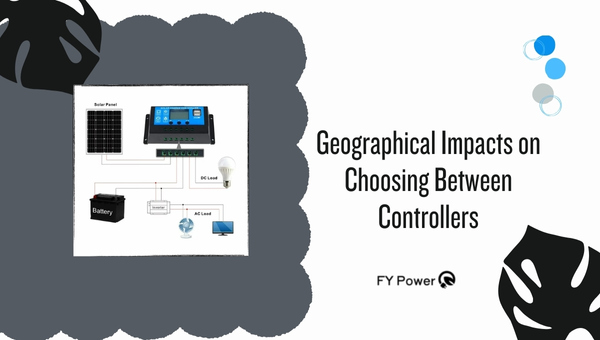
How Your Location Might Inform Your Choice?
- Sunshine All Year? Lucky You!: Places with lots of sunny days make any controller look good. But MPPT still edges out because it converts more effectively.
- Frequent Clouds or Shade? No Problem: Here’s where MPPT shines (no pun intended). Even with less light or brief shadows passing over, an MPPT squeezes out more energy than PWM can manage.
- Hot Summers & Cold Winters? Gear Up!: Great temperature swings throughout the year affect how well your solar system works; MPPT takes these changes in stride far better than PWM does.
- Predictable Weather Patterns Win: Know your area’s weather trends. Predictability helps choose between PWM and MPPT based on consistent seasonal performance.
Connectivity Conundrums – Series vs Parallel Panel Setups
When you’re setting up a solar energy system, how you link your panels—either in series or parallel—can make a big difference. This choice affects how much power your setup can pump out and what kind of charge controller will work best.
It’s important to get it right so your system runs smoothly and efficiently. Let’s dig into the details to see which charge controller shines when matched with either series or parallel connections.
Which Controller Excels Depending on Connection Type?
Choosing to wire your solar panels in series or parallel can really impact how well your whole setup works, especially when it comes to the brains behind the operation—the charge controller.
- Series Connections:
- When solar panels are wired in series, their voltages add up while the current stays the same as one single panel.
- In this kind of setup, a Maximum Power Point Tracking (MPPT) charge controller is usually your best bet.
- Why? Because MPPT controllers are designed to handle higher voltages from the series arrangement without breaking a sweat.
- MPPT controllers convert excess voltage into amperage. This means even when sunlight is playing hide and seek (like during dawn or dusk), they still manage to pull more energy than their Pulse Width Modulation (PWM) pals.
- Parallel Connections:
- In a parallel configuration, it’s like joining hands with others; each panel’s current adds up while the voltage remains at that of a single panel.
- For this scenario, both PWM and MPPT charge controllers can do the job, but there are some twists.
- A PWM might be more cost-effective upfront if you’re working with a small-scale system where voltage isn’t going sky-high.
- But if we’re talking bigger systems that need more juice consistently—even in less-than-perfect light conditions—an MPPT would again flex its muscles for better overall efficiency.
So, breaking it down simply:
- Think of an MPPT as being like someone good at dealing with high-volt situations calmly—essential for those series setups.
- A PWM is like your reliable friend who’s fine handling less intense stuff—which can be just right for smaller systems hooked up in parallel.
Each has its stage where it performs best—it all depends on what sort of solar array show you’re putting on! Just remember: getting this pairing right plays a huge role in getting that sweet spot for maximum effectiveness out of every ray that hits your panels.
Space Constraints – Mounting Space Necessities for Each Controller Type
When setting up a solar system, it’s not just the tech that matters. I also think about how much room I have to put stuff. For instance, charge controllers are a big deal in solar setups. These little boxes manage the power coming from the sun. So, it’s key to know how much space they’ll take up before I even start.
Room to Grow – Factoring in Space Availability
Every controller type has its own space needs for running right and lasting long. To keep things clear, let’s drill into what each one asks for:
- PWM Charge Controllers: Usually smaller and more basic than their fancier cousins, PWMs don’t ask for a lot of room. They get hooked up between solar panels and batteries but stay small so they can fit in tight spots without trouble.
- MPPT Charge Controllers: These guys are bigger because they’re packed with tech that makes them smarter at handling power. The upside is better performance; the sort-of-downside is that they need more real estate inside your setup.
Imagine your space as a garden – some plants can thrive in cozy corners while others need room to spread out. It’s just like that with PWM and MPPT controllers; you’ve got to pick the right one based on how big your “garden” is.
And when we talk optimal operation, we mean setting these devices up with enough breathing room so they can stay cool and not overheat. Overcrowding can cut their life short, which nobody wants after spending their hard-earned money.
So here’s my rule of thumb: always check the size specs when shopping around for controllers and match that against the space you’ve got available. It saves headaches later on!
By picking right based on size — along with other factors — ensures smooth sailing (or should I say ‘solar-ing’) down the line!
Battery Types Supported by Each Controller
When I decide on a charge controller for my solar system, I have to think about the batteries I’ll use. Different types of batteries need different types of care. Some like to be treated gently, and others can handle a rougher charge. That’s where the choice between PWM and MPPT controllers gets important.
Understanding Compatible Battery Technologies
It’s like picking the right partner for a dance. I’ve got to make sure they move together smoothly or things could get messy. Let me break down which battery types go well with which controllers:
- Lead-Acid Batteries:
- PWM Controllers: These are good buddies with traditional lead-acid batteries including sealed (AGM) and flooded types.
- MPPT Controllers: They can also dance nicely with lead acid, but they shine brightest when you need that extra precision in charging.
- Gel Batteries:
- PWM Controllers: Gel batteries don’t like it too hot or too cold, so PWMs that are simple and careful work well enough.
- MPPT Controllers: If you’re looking for a perfect charge every time, no matter the weather outside, then MPPT is your guy.
- Lithium Batteries:
- MPPT Controllers: Lithium is the fancy new tech on the block; it loves being paired with an MPPT because it needs that smart, accurate charging to keep going strong.
- Nickel-Based Batteries:
- Not as common in solar setups these days, but if you come across them, check the manual; sometimes PWM is good enough but check if your MPPT agrees too.
Distance Dilemmas – Cable Lengths from Panels to Batteries
When setting up a solar energy system, an important but often overlooked factor is the distance between the solar panels and the batteries. The length of cable you use can have a big impact on how much power gets lost before it even reaches your battery bank.
This matters because you want as much of that power as possible for your use, not wasted along cables. Let’s take a close look at how these different kinds of controllers—PWM and MPPT—affect power transmission over distances.
Lost in Transmission – Evaluating Losses Over Distance
The path electricity takes from your solar panels to your batteries can be simple or complex. But one thing’s for sure; the longer the cable, the more power you risk losing.
This is due to something called ‘voltage drop’. To help make sense of how this happens with PWM and MPPT charge controllers, here’s what needs to be known:
- Cable Thickness: For both PWM and MPPT, choosing thicker cables helps reduce power loss over distance. Thicker cables have less resistance.
- Voltage Levels: PWM controllers match the battery voltage. If there’s a long wire run with low voltage (like 12V), there will be more loss compared to higher voltages.
- Efficiency with Voltage: An MPPT charge controller can adjust inputs from solar panels down to what your battery needs without losing much energy in long wires.
So, if I have a setup where my panels are far away from where my batteries are stored, using an MPPT controller might save me more power because it works well with high voltages—you get less “lost in transmission”. With a PWM setup, I’d need very thick cables if I didn’t want too much of my electricity disappearing before it charges my batteries.
Indeed, thicker wires and shorter distances will always work best no matter what type of controller you’re using. However, since MPPT technology deals better with high voltage scenarios typical in long-cable setups, it generally ensures fewer losses compared to a PWM controller in equivalent conditions.
Choosing between these two types when planning out your solar installation gets even trickier when considering wire lengths—you have got to weigh up all factors, like how far apart things are going to be and whether that extra efficiency is worth any additional costs upfront for an MPPT system or not.
Field Testing Results – Real-World Applications Of PWM Vs. MPPT
When picking between a PWM (Pulse Width Modulation) charge controller and an MPPT (Maximum Power Point Tracking) one, looking at the facts is always the way to go. Not just the numbers on paper, but how these gadgets do their job under real skies and sunlight.
It’s all about performance in the field – that means gardens, roofs, or wherever solar panels sit soaking up rays. So let’s get into some nitty-gritty details from tests and studies that show what these two different types of solar charge controllers actually do when they’re out there in the world.
True Performance Metrics
Folks who have laid out their cash for solar set-ups want to know if they’ve made the smart choice – is it doing what it promised? It’s pretty simple: folks have tested both PWM and MPPT controllers to see which one comes out on top when it really matters.
- Tests Under Different Conditions: Some say variety is the spice of life; well, it’s also key to testing charge controllers. From blazing hot summers to chilly winters, tests have been done to see how these devices stand up to Mother Nature. Here’s the lowdown:
- In hotter weather or as temperatures rise high, MPPT keeps it’s cool better than PWM, still pushing energy efficient-like into batteries.
- But when skies are cloudy and light isn’t as strong, MPPT shows off by still grabbing more power than a basic PWM might manage.
- Battery Health: We all know what happens when we drain our phone battery again and again – it doesn’t like it one bit. Well, the same goes for big batteries hooked up to solar panels. Tests keep an eye on this too:
- Controllers need smart brains that stop batteries from overcharging or going too low – kind of like a caring nanny but for batteries.
- With proper settings tweaked just right, both controller types can play nice with your battery bank but word on the street (or should I say sunbeam?) is that MPPT does this chore with a touch more finesse.
- Real-world Juice Output: Let’s talk turkey here; watts and volts are where it’s at.
- Folks have put up identical solar panels side by side; half wired up to a slick MPPT unit while its neighbor sings along with an honest PWM pal.
- When the dust settles at day’s end, figures generally nod towards team MPPT pulling ahead with more energy saved up in those battery banks.
Smarty pants out there will tell you DIY tests don’t beat certified lab work-ups because there are lots of fiddly bits you gotta keep straight when testing like this. But even think-piece creators in labs agree after their own run-throughs: if squeezing every drop of sun juice efficiently matters to you then MPPT often crosses the finish line first against PWM in most conditions.
Alrighty then! Got numbers rattling around your noggin yet? The blueprint isn’t hard: field results shore up what plenty of sun-chasers figure — hooking up with an MPPT might pinch your pocketbook harder at checkout time but can pay off over time as day follows sunny day.
Conclusion
In wrapping up, the debate on PWM vs MPPT efficiency is much more than an academic exercise; it’s about practical performance in real-world solar setups. Understanding the nuances between Pulse Width Modulation (PWM) and Maximum Power Point Tracking (MPPT) charge controllers can make or break the effectiveness and reliability of a solar power system. Their role is undeniably crucial in managing energy flow to batteries, ensuring longevity, and maximizing output.
